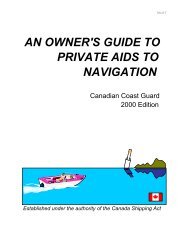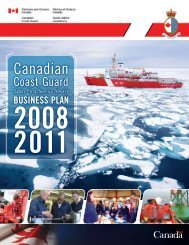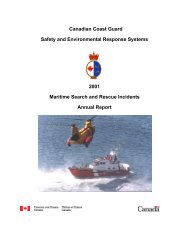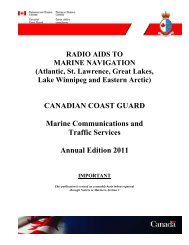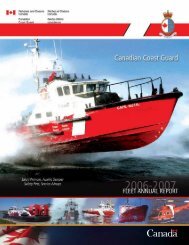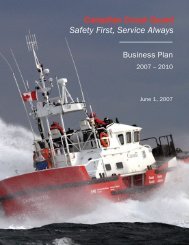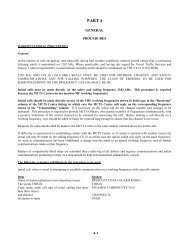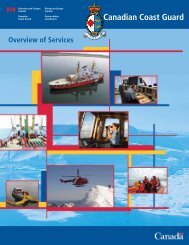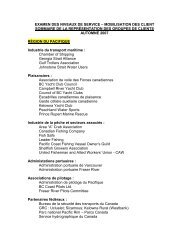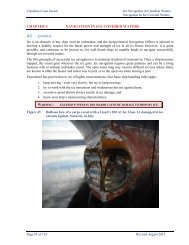RADIO AIDS TO MARINE NAVIGATION - Canadian Coast Guard
RADIO AIDS TO MARINE NAVIGATION - Canadian Coast Guard
RADIO AIDS TO MARINE NAVIGATION - Canadian Coast Guard
Create successful ePaper yourself
Turn your PDF publications into a flip-book with our unique Google optimized e-Paper software.
PART 6<br />
LORAN-C <strong>NAVIGATION</strong> SYSTEM<br />
TABLES<br />
1 GULF OF ALASKA LORAN-C CHAIN – GRI 7960<br />
2 CANADIAN WEST COAST LORAN-C CHAIN – GRI 5990<br />
3 U.S. WEST COAST LORAN-C CHAIN – GRI 9940<br />
4 NORTH CENTRAL U.S. LORAN-C CHAIN – GRI 8290<br />
FIGURES<br />
1 NORTH AMERICAN COVERAGE OF LORAN-C CHAINS<br />
2 LORAN-C COVERAGE DIAGRAM – GRI 5990<br />
3 CANADIAN WEST COAST CHAIN COVERAGE DIAGRAM<br />
4 INDEX AND CHARTLETS SHOWING ADDITIONAL SECONDARY FAC<strong>TO</strong>R CORRECTIONS<br />
A. Loran-C Chain Coverage<br />
Figure 1 shows the North American coverage of Loran-C while Figure 2 shows further details of the <strong>Canadian</strong> West<br />
<strong>Coast</strong> and suggested rates and master-secondary pairs to use in particular areas. Figure 3 shows the individual coverage<br />
pattern provided by the <strong>Canadian</strong> West <strong>Coast</strong> Chain. The following notes pertain to Figure 2:<br />
Note 1:<br />
Note 2:<br />
The dividing lines between the Loran-C rates do not necessarily mean there are no other suitable Loran-C<br />
station pairs which could be used to safely navigate in an area. For example, while it is recommended to<br />
use 5990 XZ (i.e., Williams Lake - Shoal Cove - Port Hardy on Rate 5990) in the Hecate Strait area,<br />
coverage also exists there for 5990 XY. It is simply estimated that 5990 XZ provides better coverage in<br />
this area.<br />
The position repeatability of the 5990 XZ signals in this area may degrade to 1/3 nm due to geometric<br />
considerations. Theoretically 7960 XZ should be used in this area, but this is not recommended due to<br />
weak signal strength of the distant master station at Tok, Alaska.<br />
B. Chain Details<br />
Tables 1 through 4 give technical details of chains that provide coverage in waters off Western Canada and proximity.<br />
C. Loran-C Coordinate Converters<br />
Listing of vectors from the Loran-C coordinate converter position to the true position.<br />
D. Loran-C Receiver Latitude/Longitude Corrections<br />
Today’s Loran-C receivers are equipped with microprocessors which are designed to internally compute the latitude and<br />
longitude coordinates of the receiver, based on the Time Difference (TD) readings, and directly display these values.<br />
This reduces the need to possess Loran-C charts, though it is still recommended they be procured.<br />
The latitude/longitude computation may be based upon a pure seawater path. This leads to errors if the Loran-C signals<br />
from the various stations involve appreciable overland paths since the speed of the signal will decrease by varying<br />
amounts, depending on the nature of the earth’s surface over which it is passing. Loran-C operates by measuring the<br />
difference in arrival times of the signals from the different stations in the Loran-C chain, and thus any unforeseen<br />
variation in the speed of a signal will result in an error in the latitude/longitude reading. Note that when the receiver is<br />
being used in the time difference mode (time difference readings being used to manually plot lines of position on a<br />
6-1




